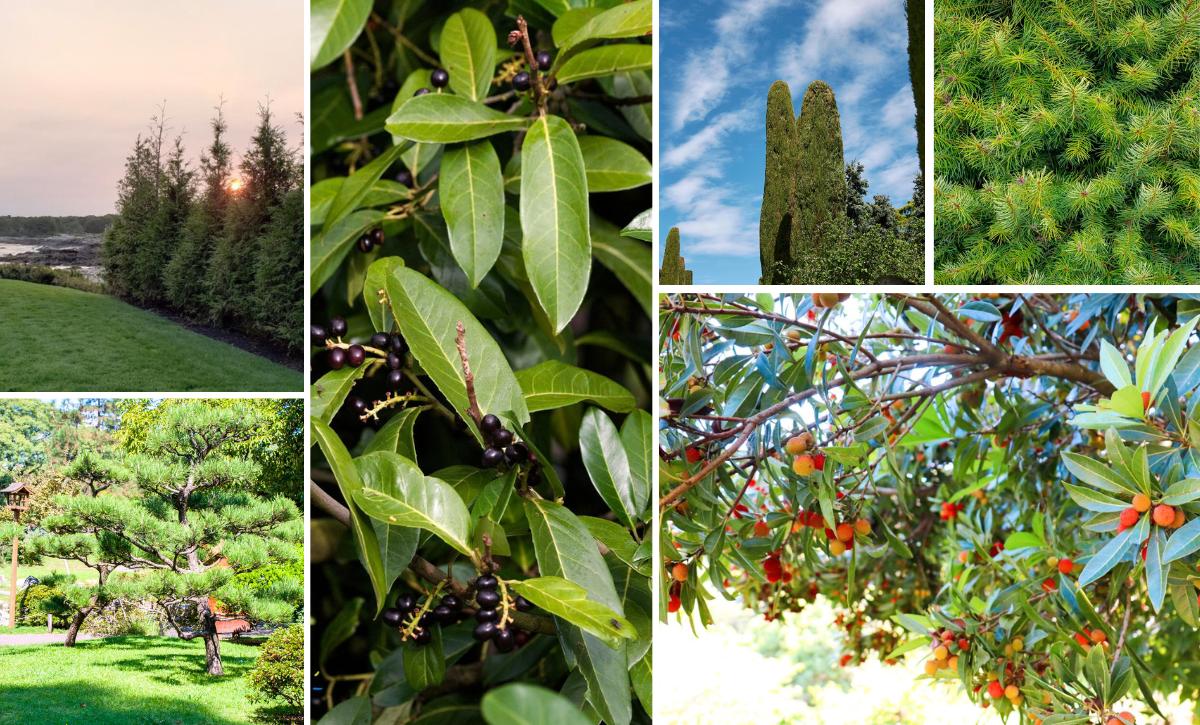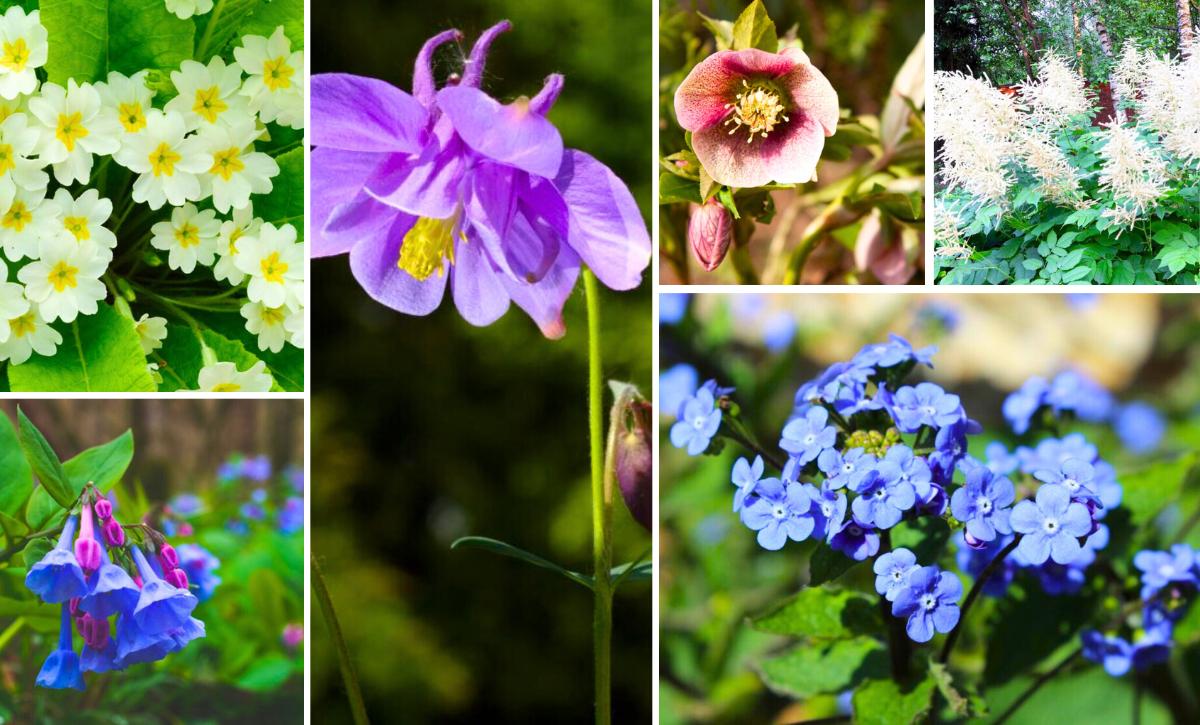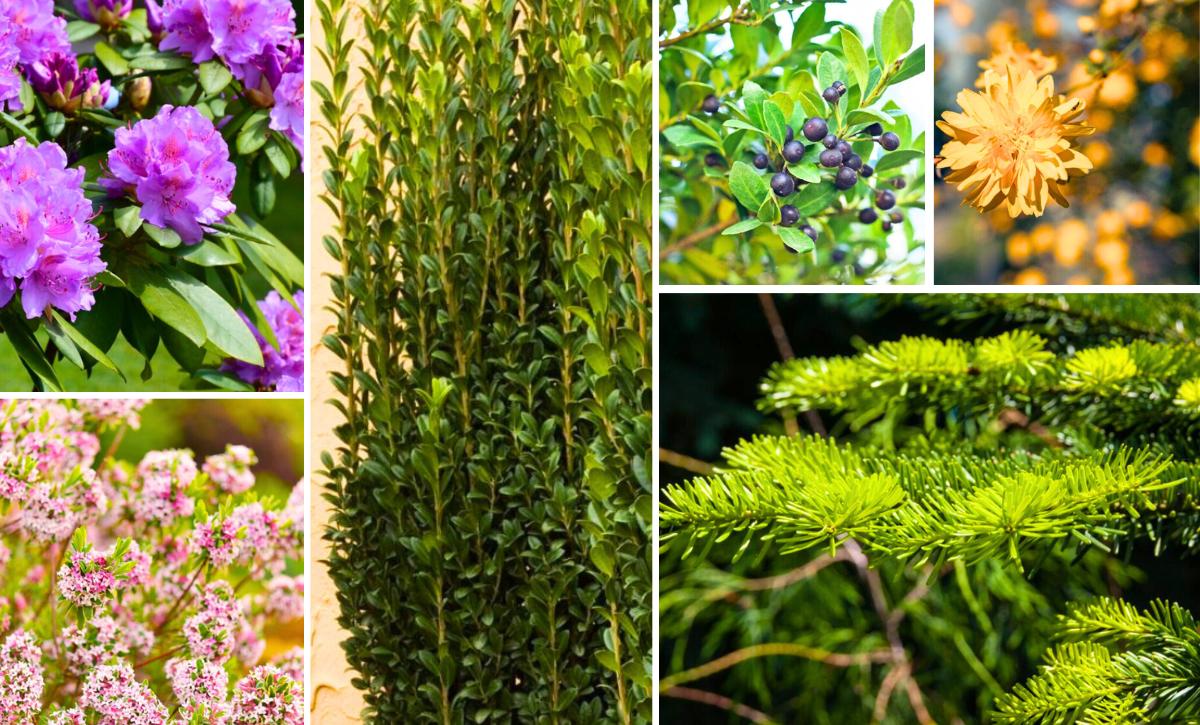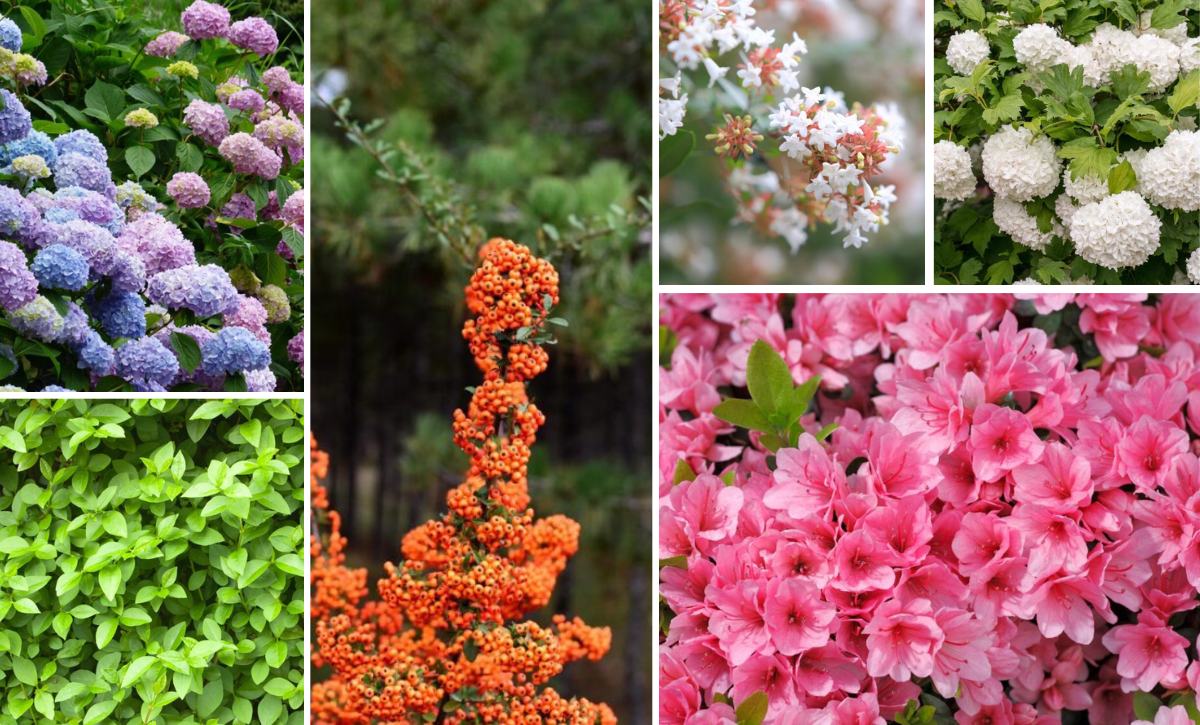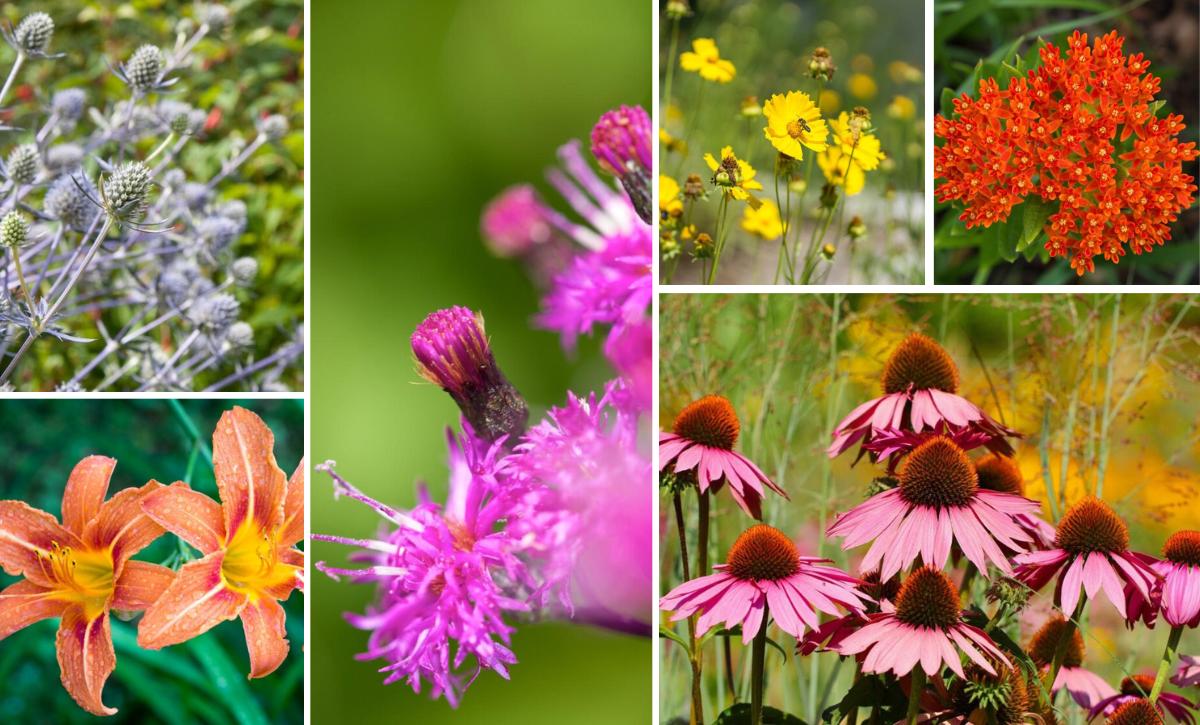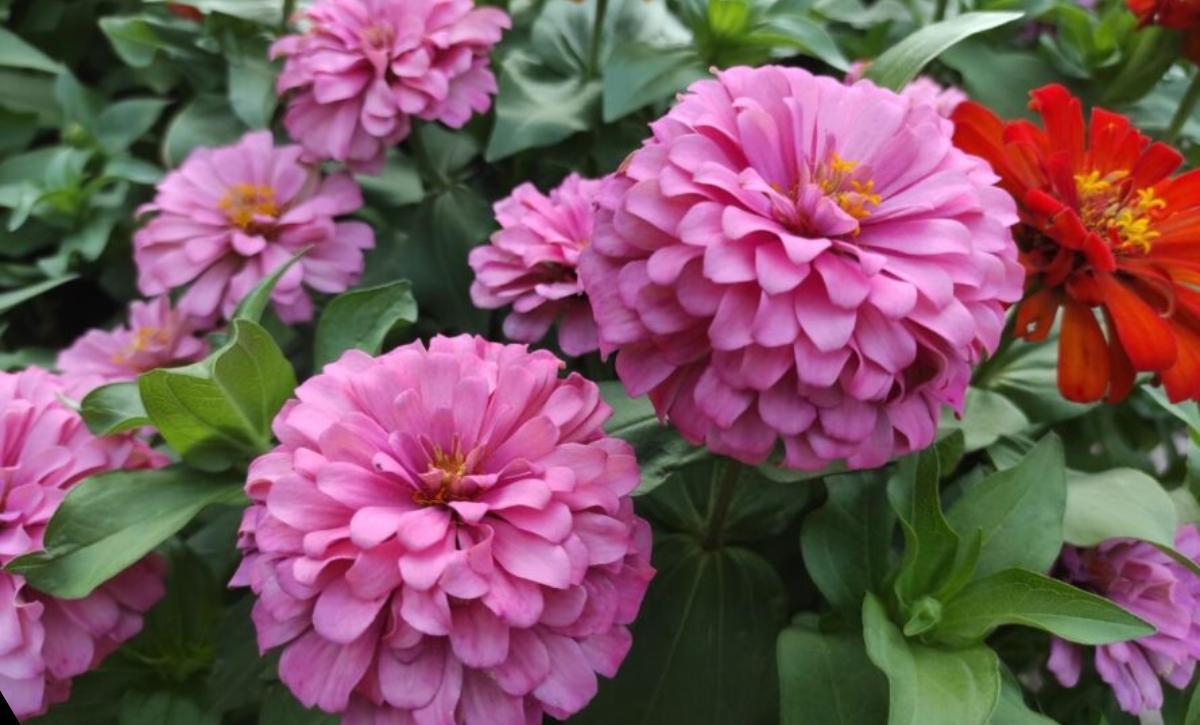Seeing little berries on the side of the road can be tempting, especially if the berries seem juicy and tasty enough. But wait, avoid this temptation; berries may be pokeweed berries, especially those resembling blueberries.
The color and juiciness of these berries make them very tempting. Before you do something rash that you may regret in the future, it’s important to understand whether pokeweed is toxic.
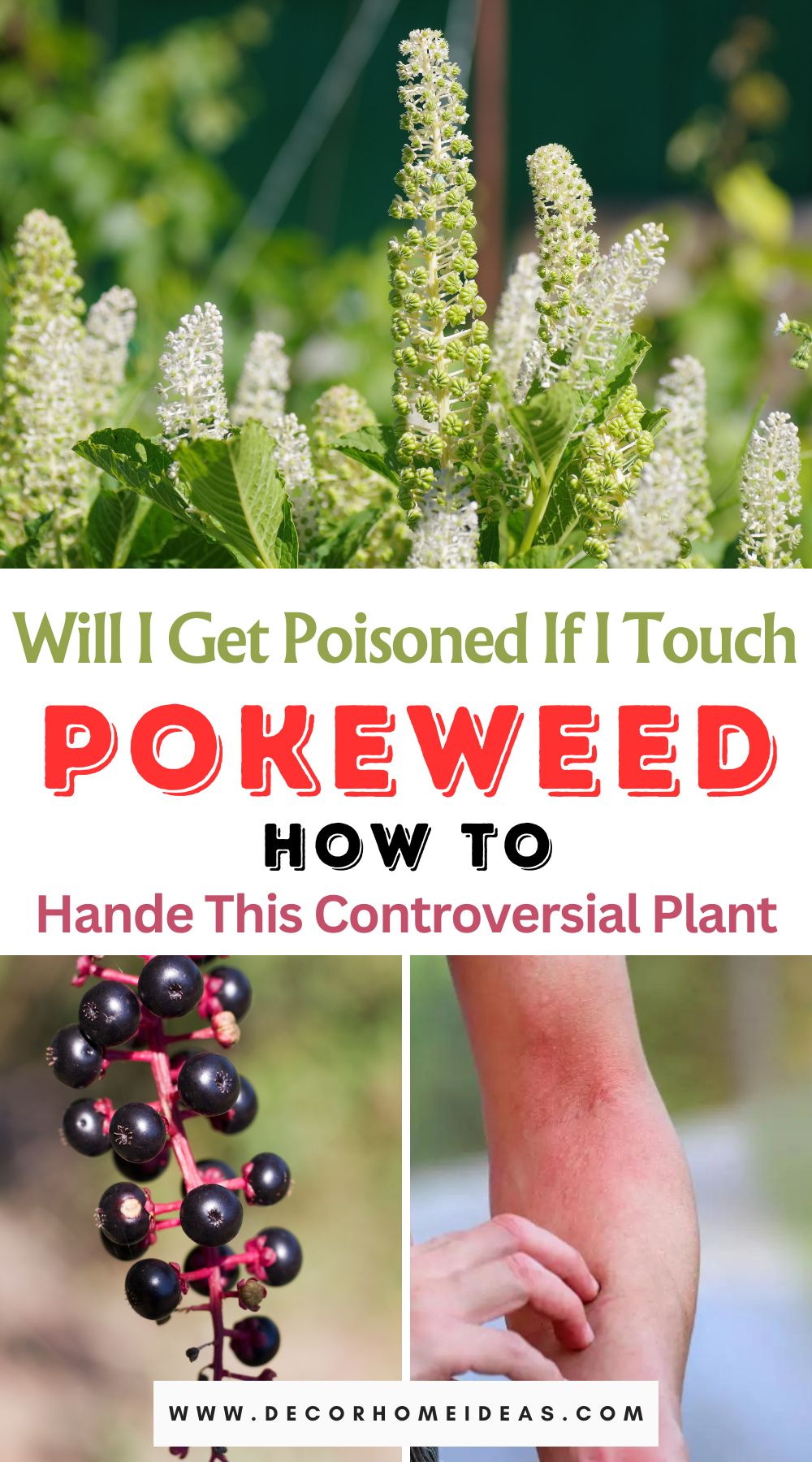
In this article, we’ll explore all you need to know about the toxicity of pokeweed.
Let’s get started!
Is Pokeweed Poisonous To Touch?
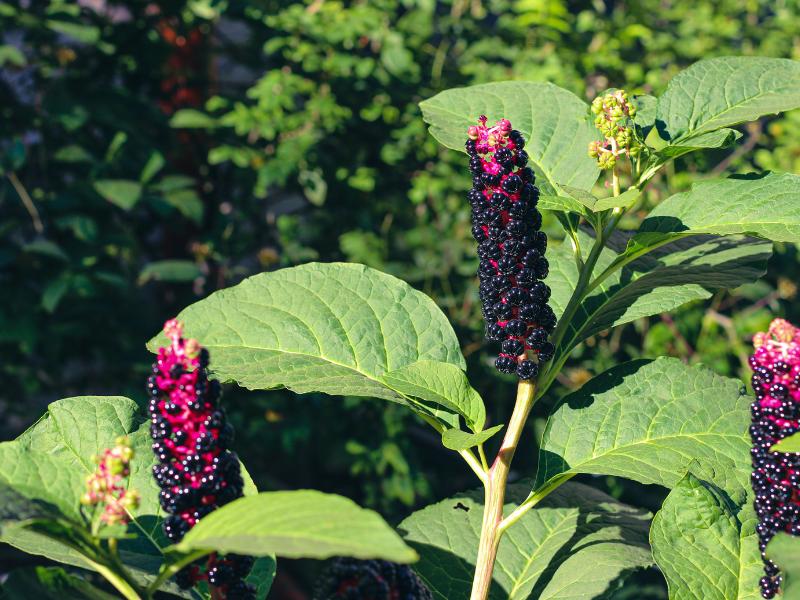
Pokeweed is one of the native herbaceous plants found all over the United States, and yes, it’s actually poisonous. Also known as the Phytolacca americana, this weed can survive in various soil types and is considered invasive. This is because a single plant can produce up to 50,000 seeds.
Pokeweed exists abundantly and probably wouldn’t be such a menace if it weren’t toxic. Animals and birds can also easily distribute them by eating or dropping them off.
So don’t let these berries’ juicy and beguiling color fool you. Eating them is a very big mistake.
You may wonder whether touching other parts of this plant is toxic, too, and the answer is yes. Other features of this plant are also poisonous, especially the leaves and the roots. To err on the side of caution, you should also stay away from ripe or unripe berries, old leaves, stems, and even the seeds of this plant.
Touching the plant with broken skin is even worse since the toxins from the plant can enter the bloodstream, and it could affect your respiratory and digestive systems. This could then escalate to affect other body parts that we’ll examine in detail later on.
Exposing any part of this plant to your skin could cause pokeweed rash, which has similar effects to poison ivy or oak rash. Other common effects include redness, blisters, itching, and inflammation. You can treat small cases of pokeweed poisoning at home, but you’ll have to seek medical attention in severe cases.
Pokeweed Toxicity
So, what exactly is in this plant that makes it so toxic?
This native North American plant is filled with toxins such as Phytolaccigenin, Triterpene saponins, and Phytolaccatoxin.
The saponin glycosides in the plant cause a GI injury. These two glycosides (phytolaccatoxin and Phytolacca) cause fulminant gastroenteritis, diarrhea, and vomiting within 2 to 4 hours after ingesting the plant. Due to the loss of gastrointestinal fluids, one may also experience hypotension. Consequently, you may experience signs like weakness, seizures, unconsciousness, respiratory depression, and other side effects, especially if the poisoning is severe.
Species such as the P. americana that have mitogenic, antiviral, and hemagglutinating compounds may cause even more damage. Plasma cells and lymphocytes may undergo some morphological alterations due to the mitogen present in the pokeweed. Touching or ingesting the P. americana pokeweed with broken skin may cause the formation of proplasmacytes and plasmablasts, thrombocytopenia, and eosinophilia.
Even though some people may say that pokeweed isn’t toxic, it’s important to remember that all this has been scientifically proven. In the past, native Americans used pokeweed as food and even in making medicine. But without the wisdom of the old, it isn’t easy to use this plant this way. Today, the weed may have some uses in medicine, which rely on the effectiveness of the substances that it contains.
Many invasive plants are usually toxic as a defense mechanism to prevent them from being eaten by animals. The only upside to all of this is that these plants aren’t deadly to animals; they are simply unsettling. Still, it would be best to avoid them.
Symptoms of Pokeweed Poisoning
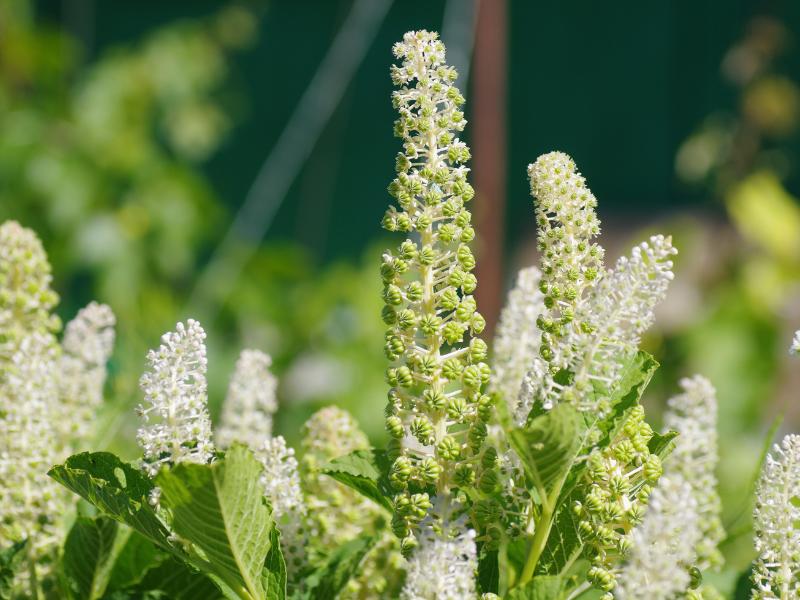
Pokeweed also has other common names such as American Nightshade, Cancer root, Inkberry Coakun, Virginia poke poisoning, pokeroot, and Pookan Bush, but it’s collectively referred to as pokeweed.
Other than skin irritation, some of the toxins in the plant can cause low blood pressure, nausea, headache, stomach pain, vomiting, convulsion, diarrhea, incontinence (loss of urinary control), heavy breathing, seizures, muscle spasms, and irregular heart rate; in some cases it may also lead to an allergic reaction.
These symptoms will manifest within 2 – 6 hours after ingesting the pokeberry or pokeweed.
Other than the toxins present in the plant, it also has some elements that will be impaired with medication, such as anticoagulants (prevent blood clotting), for example, Coumadin, and antihypertensives (lowering blood pressure), such as ACE inhibitors.
Let’s examine these symptoms to see exactly how they occur.
Seizures
The American Nightshade plant produces the phytolacca protein, which instantly lowers blood pressure. This is, in turn, followed by difficulty in breathing and cardiac distress.
Since the brain is deprived of oxygen due to respiratory problems, seizures become a potential side effect of ingesting or consuming pokeweed.
Irregular Heart Rate
As we previously stated, pokeweed can cause potential side effects of medication that facilitate normal blood flow through the veins, vessels, and heart. When the normal blood flow in the body is altered, it can cause an irregular heart rate.
One of the ways that pokeweed can induce this is through toxin-induced blood artery constriction. This causes the body’s blood pressure to drop, slowing the heart rate. As such, the heart has to work extra hard to compensate for the low blood pressure. The heart rate will also increase when the exposed individual is subjected to physical activity.
Muscle Spasms
Low blood pressure may also result in muscle spasms. By lowering the blood pressure and closing blood vessels, the toxins prevent the muscles from getting enough oxygen, which they need to operate efficiently, which then causes muscle spasms.
If you are wondering what muscle spasms are, they are the involuntary contraction of muscles. This makes it very challenging to relax the affected muscles.
Steps To Take After Pokeweed Poisoning
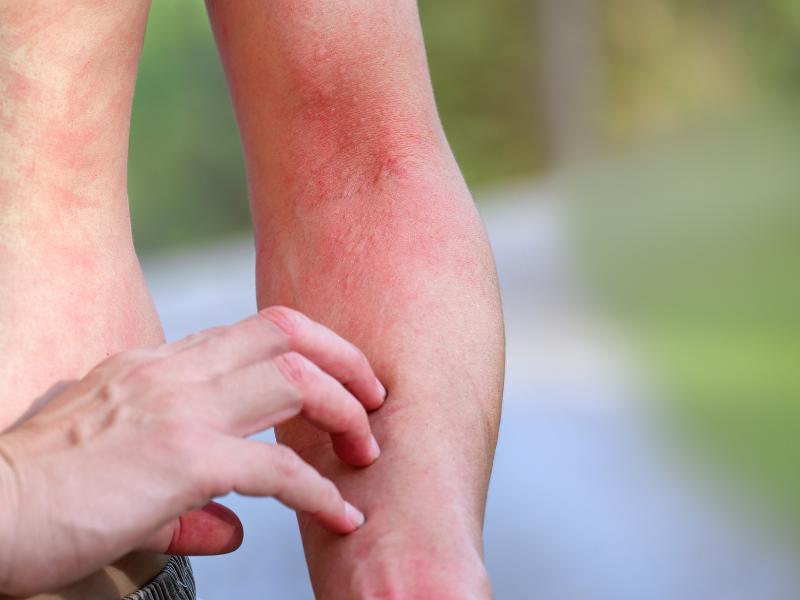
Before taking any other steps, you should first determine the severity of the poisoning. Accidentally touching the plant will cause a mild rash, and you can easily treat it at home. If the poisoning is more serious, say you have eaten the pokeberry fruits or the plant has been all over your skin and eyes, you must visit the emergency room immediately and seek help from a professional.
If your pets or animals have ingested or come into contact with this toxic plant, you must contact animal control immediately.
Inducing vomiting is one of the first aid protocols that people tend to take, but you should avoid it if you have pokeberry poisoning. Remembering the parts of the plant you have touched or ingested is also important. Different parts of the plant have different toxicity rates, so your doctor may want to know exactly which part of the plant you have consumed.
Generally, pokeweed may harm you severely, but it won’t kill you. There has been one reported fatality where a small child succumbed to the poisoning after drinking juice made from crushed pokeweed seeds.
What to Do About Pokeweed Rash
The best home remedy for pokeweed rash is washing the affected area with lukewarm water and soap immediately after you have come into contact with the plant. You should also immediately change your clothes and wash them.
Your skin may get a bit itchy, but scratching it will lead to a much bigger issue. For example, your skin could tear, and this could lead to secondary infections, which will make the conditions much worse.
To ease the tingling feeling on your skin, use anti-itching ointments that prevent you from scratching yourself. You should also apply something like ice to help reduce the inflammation.
With time, the itching may get intense and spread, which may become unbearable, in which case you’ll need to visit the emergency room. Other critical symptoms that may require immediate medical attention are chest pains and difficulties in swallowing and breathing.
What You Should Know About Pokeweed
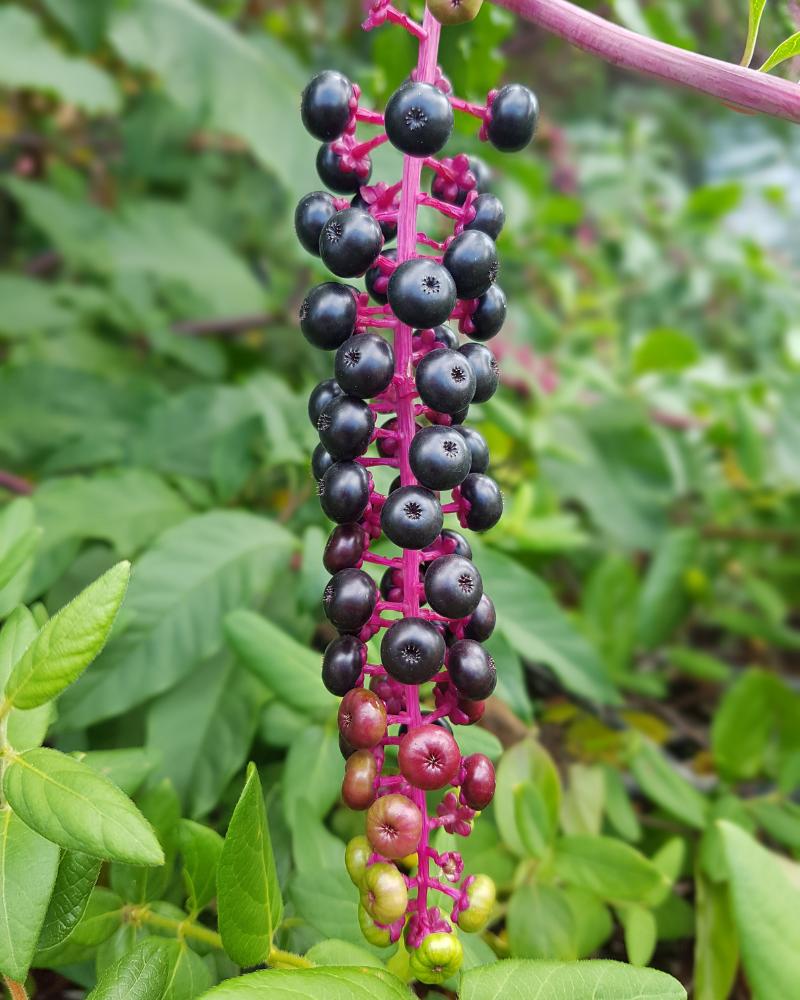
The first and probably most important thing to know about pokeweed is that it’s an invasive plant, and even without being planted, it can easily start growing in your garden. As such, you should learn to identify and get rid of it as soon as possible to prevent the risk of possible poisoning for you and your loved ones.
In this section, we’ll examine how to identify this weed and its traditional and modern uses in medicine, which is the only time it’s acceptable to eat pokeberry.
Let’s get into it!
Pokeweed Identification
Since pokeweed is such a toxic plant and consuming it can be harmful, it’s important to learn how to identify it and ensure you get rid of the right plant.
For example, imagine grapes or blueberries growing in your garden and pokeberry weeds invade the garden. It may not be easy to distinguish the plants from each other at first glance.
The easiest way to identify pokeweed plants is to examine the leaves. The leaves are oval-shaped, ranging from 5 to 10 inches, with a very smooth texture. Another clear distinction of pokeweed leaves is that they are dark green on the outside and have a pinkish tint on the inside.
At the blooming time, these fruits produce green-white flowers, which turn into pokeberries.
Pokeberry plants grow to about 10 feet tall. This feature should make it easy to identify if you are growing your plant among ground covers. Blood-red stems are also another distinct feature that you can use to identify pokeberries.
Regarding roots, this plant has an extra long, white taproot system that has a fleshy appearance. This should make it easy to identify once you have dug out any weeds you suspect are pokeberries.
To be absolutely sure, you should also examine the pokeweed berries. The fruits of this plant resemble grapes. As with all plants from this genus, they develop in groups and hang from red stems.
How to Get Rid Of Pokeweed
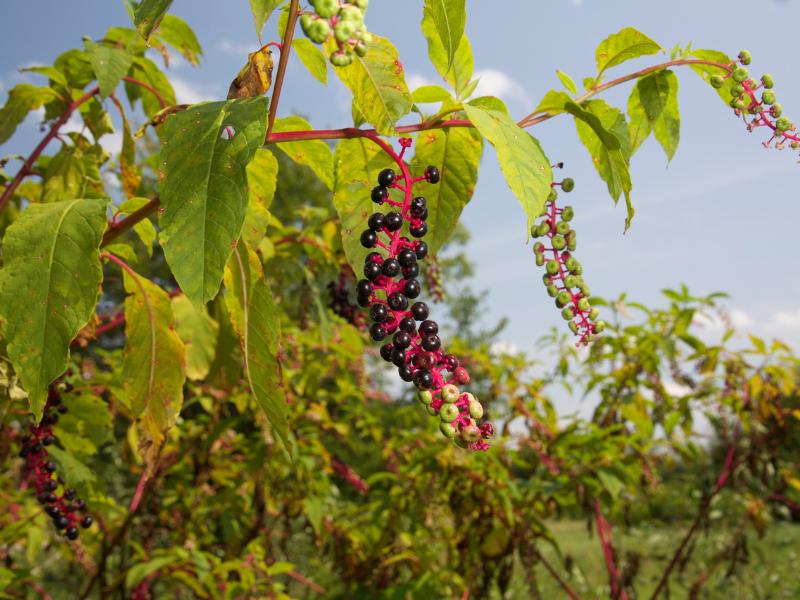
There are a variety of techniques you can use to get rid of pokeweed. This includes digging up the plants, repeatedly cutting the plant, or applying weed killer. Choose the option that’s acceptable to you.
1. Use your Hands
If you prefer organic farming, then this is the method to use. You don’t need any specialized equipment or chemicals in this method. Just use some protective equipment, such as gloves and goggles, to protect you from the plant’s sap in case the pokeweed bursts and causes skin or eye irritation.
This will be a piece of cake for gardeners with experience in digging out plants such as carrots. Simply grip the plant by the base and pull it up. You’ll notice taproots with thin roots if you have done it right.
For people with dense clay soils, you may want to try an alternative method since clay soil is thick, making removing the plant harder. This manual method works best with light soils.
2. Dig Out The Pokeweed Plant
Pulling larger plants straight out of the ground may be difficult, so you may opt for more sophisticated methods like digging out the plant, especially if the soil is compact.
Before you start gardening, you’ll need a few tools, such as a rake, safety gloves, a gardening fork, a cart or a wheelbarrow, a tarp sheet, and a gardening hoe.
First, remove the soil around the plant, then remove the small shoots around it and start digging around it. Once you have dug out the whole plant, place it on a tarp sheet and let it dry out, then remove any berries or seeds around the soil so they don’t regrow.
3. Cutting Down the Pokeweed plant
With this method, you must exercise much caution since the pokeweed must be trimmed continuously. You must also check the stump frequently to determine whether it has started growing again. In most cases, once you have completely trimmed the plant, the taproots energy will deplete, and the plant will stop expanding.
You’ll need some shears and proper protective gear to prevent your skin from coming into contact with any part of the plant.
First, remove all the berries or seeds on the plant and place them in a plastic bag to prevent them from spreading. Then, use gardening shears to cut the plant down at the base or simply use a lawnmower to mow over the plants if several plants are clustered.
4. Apply a Weed Killer
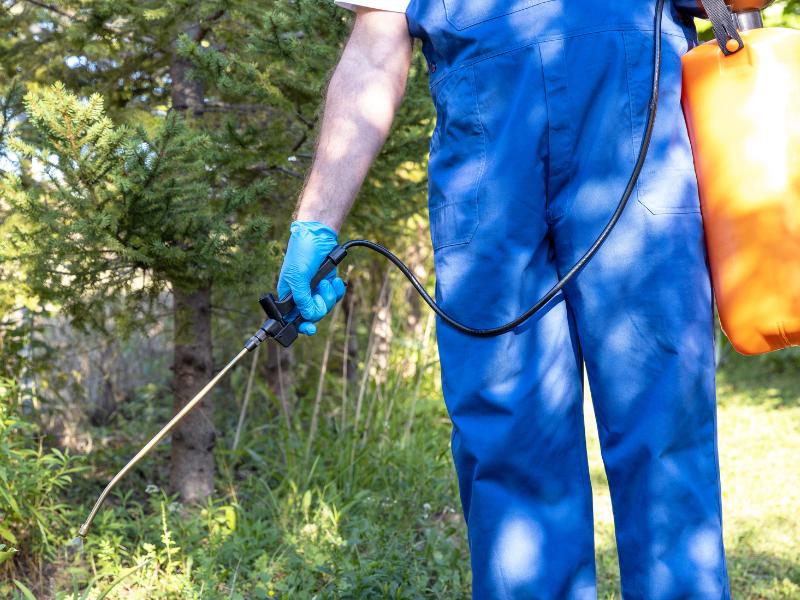
Applying a weed killer is your answer if you want a fast and effective method to eliminate pokeweeds. This method takes a short time to be effective and is a good solution for compact soils.
Depending on the plant’s development stage, there are different ways to apply a weed killer. This method will be utterly effective for young plants in completely eliminating the plants from your garden. Larger plants with well-developed and deeply ingrained roots may need more than just herbicides to remove.
Weed killers should be applied once the plant has been effectively dug out from the ground to prevent regrowth. Ensure that you wear protective gear when using this method to avoid the pokeberry from harming you and protect yourself from possible side effects of the chemicals.
One common herbicide is a glyphosate herbicide known as Roundup Max Control. For this weed killer, you have to dilute it with at least two liters of water. Your pokeweed plants should be ready for disposal ten days after you have applied the chemical to the plant leaves.
Distilled vinegar is another simple home remedy that can act as a herbicide. Since it’s a strong natural acid, vinegar can burn the roots and stop the pokeweed menace.
Traditional Medicine Use
As we previously mentioned, pokeweed has been used as medicine by Native Americans. The first use of this plant has been as an emetic (to encourage vomiting). Secondly, pokeberry has been used as a laxative (to encourage or stimulate bowel movement). People also believe species such as P. Americana can naturally clean the body.
Other common uses of pokeweed have been in treating syphilis, skin diseases, scabies, painful menstruations, treating diphtheria, etc. Since this plant has high toxicity levels, medical use requires specialized training.
Some common parts of the plants that have been used for medicine are:
• Leaves – Cathartic and purgative
• Root wash – This has been used for swelling and sprains
• Tincture of the root – One of the most useful parts of the plant in terms of medicine. It’s good for skin conditions, tonsillitis, arthritis, edema, lymphatic disorders, and cancer.
Surprisingly, people have consumed these berries as an arthritis remedy without chewing the poisonous seeds. A person takes one for the first day and an additional one for each subsequent day for up to seven days.
• Ash from the plant – The high potassium content of this plant makes it useful in treating cancer.
• Root poultice – Poultice made from the roots of this plant has been used to treat breast abscesses. Roasted root ashes can also be used. Poultice can also be used in treating rheumatic pain and swelling.
Modern Medical Use
Despite its toxicity, it has been scientifically proven that pokeweed has several health benefits. It was declared that this plant has similar toxicity levels to other pharmaceutical drugs that are already in supply.
One of the most important compounds in the plant is the PAP (pokeweed antiviral protein). This compound can be extracted from the leaves and has shown significant benefits in improving the skin and treating viral infections such as HIV and herpes.
Cancer Treatments
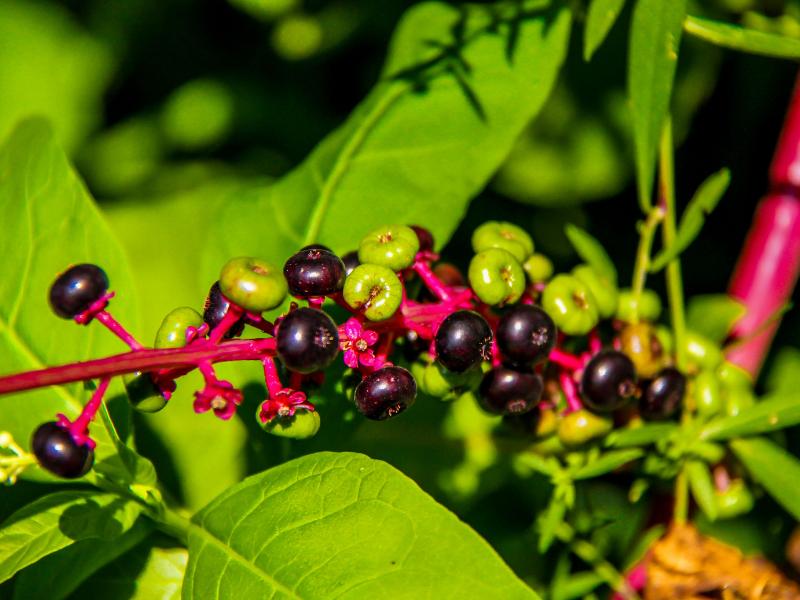
Pokeweed has compounds with anti-tumor, immunostimulant, and anti-inflammatory properties, which is the primary reason this plant has anti-cancer effects. The phytolacca toxin’s antiplasmodial or cytotoxic components are also useful in fighting cancer.
Other compounds suspected but not yet proven to have anti-cancer effects are the pokeweed plant’s antibacterial, anthelmintic, and antiviral characteristics.
However, the main anti-cancer property of the plant mainly comes down to the PAP protein. This compound can inhibit ribosomes; a crucial organelle for protein synthesis in the body. Cancers such as leukemia, melanoma, and breast cancer are thought to be caused by ribosome mutation.
Since PAP inhibits ribosomes, they cannot mutate, hence the anti-cancer ability.
In a study done in 1993, it was seen that the PAP protein was designed such that it binds to the CD4+ immune cells. Since this is the cell that HIV primarily attacks, PAP may also help fight this virus.
You should note that all this evidence is from case studies made throughout the years, so there isn’t concrete evidence that consuming pokeweed will have a similar effect. However, this plant shows promising results for new drug results and further drug improvement.
Tonsillitis
Natural components such as lignum vitae, capsaicin, and pokeweed are present in homeopathic remedies used to treat tonsillitis.
These components can soothe inflammation, pain, and scratchiness without interfering with the mucous membrane of the throat.
Anti-inflammatory for Skin Conditions
As discussed in previous sections, pokeweed has plenty of anti-inflammatory properties. The plant’s taproot has several compounds, such as saponins and triterpenes, that help with this.
While it may seem a bit paradoxical since one of the main toxic effects of this plant is causing a rash, it has applications in treating eczema, scrofula, and psoriasis.
In some cases, this plant has also shown anti-inflammatory effects that help relieve pain and reduce swelling.
Food Uses
Surprising right? You are probably wondering: I thought this plant was toxic!
Well, it’s still toxic. However, with a skilled chef, the right amounts, and proper cooking, pokeberries can be used in making delicious salads and pies.
You can harvest young leaves as a spring green herb. It would be best if you blanched them before consumption repeatedly. Shoots can also be harvested and eaten as an asparagus replacement after being blanched with multiple water changes.
I wouldn’t recommend consuming this plant with the stakes being so high. But, if you have to, consume it once in a while.
Another good use of pokeberries is in making dyes. You can make beautiful magenta dye, though it washes off easily. It’s rumored that the ink people used to sign the Declaration of Independence was made using pokeberries.
Frequently Asked Questions
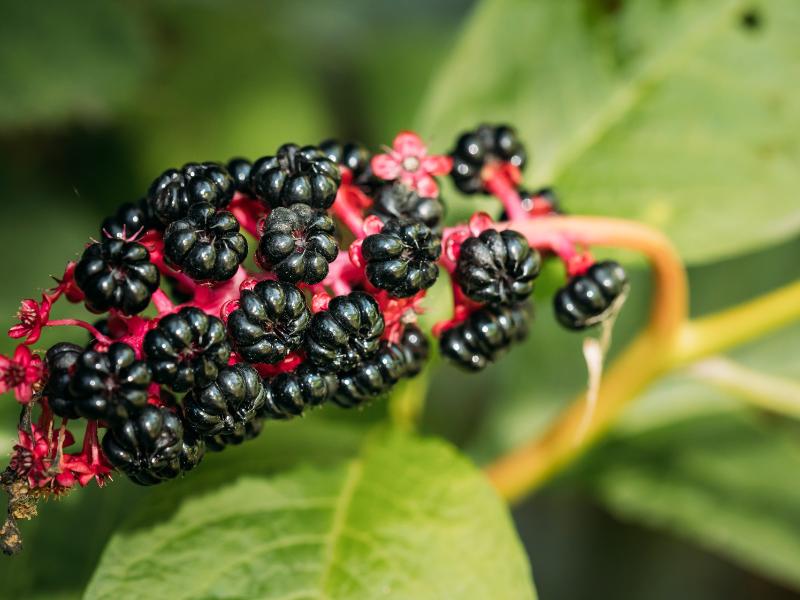
1. What should you do if you touch pokeweed?
If you have accidentally touched pokeweed, take first aid measures such as washing the affected areas with lukewarm water and soap as soon as possible. Waiting for longer allows more toxins to absorb into your skin and reach the bloodstream, which may cause even more serious poisoning.
Apply some calamine lotion to the area if you have access to some. In severe cases, you have to seek medical attention.
2. Is pokeweed toxic to humans?
Yes, this plant is toxic to humans and animals, especially if consumed in large amounts.
Some of the common effects of ingesting this plant in humans include headache, nausea, vomiting, diarrhea, low blood pressure, loss of urinary control, heavy breathing, seizures, muscle spasms, and irregular heart rate.
Lethal dosage may differ between adults and young children. While it takes up to 17 berries to kill an adult person, it’ll only take two berries to kill a child.
So, take caution, keep this plant away from your garden, and warn your kids to keep away from the plant should they stumble upon it.
3. What is pokeweed good for?
Despite its toxicity, it has been scientifically proven that pokeweed is beneficial to our health. Some of the compounds contained in this plant, such as PAP protein and saponins, have anti-inflammatory and anti-cancer effects.
It may seem archaic and strange indeed. But, in some folk medicine, pokeweed treats different skin conditions.
It has also shown medicinal properties in treating tonsillitis, painful menstruation, and swelling of the nose and throat. When using it for medicinal purposes, stay on high alert since there is a thin line between beneficial and harmful.
Summing Up
We should have provided exhaustive information on the toxicity of pokeweed.
It’s best to avoid touching or ingesting this plant at all costs. Even though the plant has irrefutable health benefits, only consume or use it for medical purposes after talking to a herbalist or a doctor. This will also ensure that you take the plant in the right dosage to reduce the chances of poisoning.
Some people may say it’s okay to eat this plant, but our bodies all react differently to different elements. Who knows how yours will respond to the toxins in pokeweed? It would be ill-advised to consume the plant until you know better.

